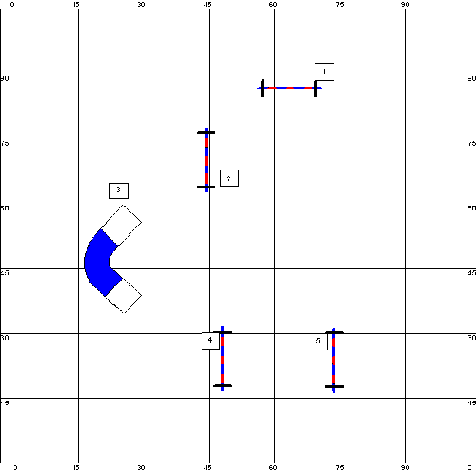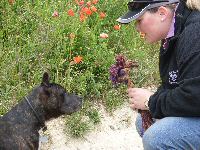Reward and you shall be rewarded...
 Alex
Collins offers a video service for agility handlers who want their runs at shows recorded so
they can assess their own performance, spot their mistakes and improve their overall handling.
Having watched more than 3,000 runs this year, she believes that she has spotted some interesting patterns
amongst handlers at all levels and would like to share her thoughts with you for the benefit of all handlers. Alex
Collins offers a video service for agility handlers who want their runs at shows recorded so
they can assess their own performance, spot their mistakes and improve their overall handling.
Having watched more than 3,000 runs this year, she believes that she has spotted some interesting patterns
amongst handlers at all levels and would like to share her thoughts with you for the benefit of all handlers.
I think you can
guess what the first observation is. It's the reward... or lack of it! I am pretty sure I can
count on the fingers of one hand the number of times per show that I heard a handler verbally
rewarding their dog during a run excluding NFC. I'm sure you reward enough in training so why
not in the ring?
We are all guilty of it.
We guide our dogs round 17-20 obstacles with minimal or no encouragement until the finish
line. The times when the dogs were verbally praised/rewarded mid-course, were few and far
between. Those priceless moments, Those moments captured on camera, gave me that warm, fuzzy
feeling and made me think 'We don't do enough of that!' We must have a little bit of air left
in our lungs to get out a 'good boy' or 'Yes!' mid-course. It
can only be a good thing to reinforce the correct behaviour and, in most cases, continue to
motivate your dog and maintain their confidence throughout the rest of the course.
My
second observation is about how handlers deal with - or not in most cases - a mistake
during their run. In your next training
session, count how many obstacles your dog completes before you reward. I bet, on average, it's
no more than 6-8. Yet, in a competition we expect them to complete
double that number before they get any reward. If you are lucky enough to have had
your run filmed - whether by me or someone else - it would be an interesting exercise to try
and pinpoint at least two opportunities
where you could have verbally rewarded your dog.
The next time
you are at training, add a vocal reward into your visualisation of the course and make a
conscious decision to prasie your dog at that point. Set yourself up for success and choose
places in the course where you are confident that you and your dog are less likely to fail.
Just be aware that if you do fail in that area, it was probably because you cued the dog
incorrectly. It is your responsibility as the handler to make sure the ring is a really great,
fun place to be so don't be afraid of verbally rewarding as you go. Don't wait until the end.
Something
worth thinking about
I have observed that dogs get more feedback/reaction when a handler makes a mistake than when they get it right. Are we, therefore, subconsciously reinforcing
the 'wrong' behaviour?
This brings us
back to my first point about the positive reinforcement/reward. Once a mistake has been made,
a handler has most likely to stop 'handling,' leaving their dog 'in limbo' as they wait, increasingly frustrated and confused,
for the next cue. Dogs with less drive/confidence noticeably 'withdraw' and freeze
up when this happens and lose the rhythm of the course. Then the handler is more likely to make
another mistake because the handler is in the 'wrong place' and the dog is travelling
at a different speed and angle to the jump/tunnel.
If you can get
your run filmed, a good thing to do is to go back and work through what
you could have done differently and visualise it. The more you visualise it, the more likely
you are in that situation you will react better and more quickly next time you are in that
situation.
Recovery is everything!
Having watched so many runs in the course of my work, I noticed a pattern developing amongst the top handlers.
Yes, they make mistakes,
too. If they go wrong they don't give up. They try to recapture their rhythm and finish the
course in full flow, making the most out of their run and regaining their dogs confidence.
It was very
successful in providing the best opportunity for the dog and handler to complete the rest of
the course in full flow, and therefore undoubtedly regaining any lost confidence. From my
experience, I noticed that approximately 80% of the dogs that I videoed handled this way
completed the course without any more faults.
Its difficult to visualise and
explain in just words so clicking on this link should help you visualise my point. The above observation became crystal clear on
this lovely Steeplechase course. In the clips I have recreated 1-5 of the course.
Alternatively this course plan and description should help.
|
Picture
this. Your dog comes out of the tunnel and runs inside the wing of jump 4. You call your dog
back -now on the left hand side of the handler - swinging them across in front of you onto your
right hand side and re-cue your dog over jump 4. On many occasions, your dog is then so focused
on you they miss jump 4 again so the whole 'swinging' process start again. Your dog then gets
confused and frustrated because the rhythm has been broken and he is looking at you waiting for
the next cue.
After the
second attempt, you still can't get your dog to go over jump 4 (if he hasn't back jumped it by
now) so you decide to reposition yourself and your dog by the tunnel exit to get a better run
up. By then you are in the wrong place and your dog jumps no. 4 and knocks it down as he is
looking back at you over his shoulder because you having been so fixated on jump 4 you haven't
given the next cue.
I'm sure you
can all picture this now don't worry we have all done it before. See how many times you
catch yourself doing it, and ask yourself what what you are doing about it? I believe it's
all about changing your mind set and learning how to handle your dog to ensure the
best recovery - and it all starts in your training.
|
 |
 There is
hope! There is
hope!
Going back to your dog missing jump 4
the best recovery handling went a bit like this. Your dog comes inside jump 4. You keep the
dog on your right side and in a smooth arc pull your dog round and cue your dog over jump 2,
then the tunnel, then give a very clear cue for jump 4, and then verbally reward and send onto
the next jump.
The benefits from this second handling technique include your dog repeating
the sequence, rather than just the jump. Your dog learns more and has a positive experience
from repeating the sequence, without losing rhythm, drive and confidence. Being swung around
in all directions, highlighted in Technique 1, causes loss of rhythm, confusion and
frustration, not to mention the increase risk of making more mistakes on the remainder of the
course. Your dog learns through the positive reinforcement of completing the sequence of 2-4
and the subsequent reward. Then you are in the correct place to continue your course which
conveniently matches what you visualised when walking the course.
As a handler
you need to make a quick decision. Do you risk another penalty later in the course (which
probably won't run as smoothly as you originally intended) thus jeopardising your dog's confidence
or do you re-run the sequence and learn from it whilst maintaining confidence and rhythm for both you
and your dog, but get eliminated? I know which option I would choose.
Having filmed some of the
Advanced handlers, I can see why they are successful and feel that we can all learn from them.
I hope in sharing my observations of them it provokes thought and discussions amongst handlers of all levels
and makes us all more aware of what we are doing in the ring which will ultimately raise standard of agility.
Good luck and happy training and competing.
 About
the author... About
the author...
Alex Collins first started agility in January 2008, after adopting Arnie from Battersea
Dogs Home at Windsor in October 2007. She quickly became addicted to the sport. Having many
years experience in teaching horse riding, she was - and still is - very interested in
understanding 'why' not just 'how' to do agility.
She has been teaching agility
since March 2010.
For more information about her
show videoing services to go
www.dogvidco.co.uk
Published 14 June 2011
|  There is
hope!
There is
hope! About
the author...
About
the author...